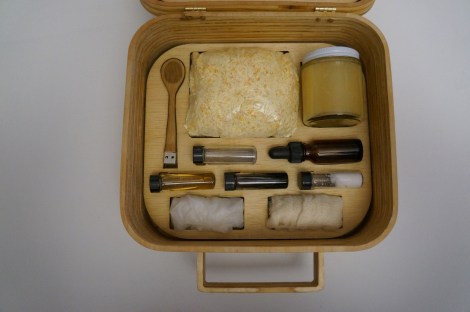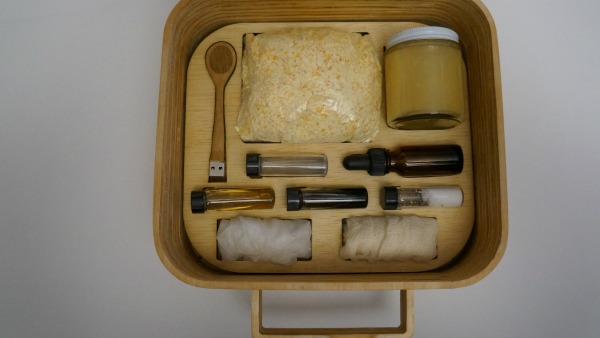Just in case there wasn’t enough high-fructose corn syrup in the world, there’s now a way to make it in your kitchen. For her master’s thesis at Parsons The New School for Design, Maya Weinstein has created a chemistry kit that allows home enthusiasts to unlock the mysteries of industrial corn refining.
Inside the kit is everything you need to make what Weinstein calls “small-batch, artisanal, high-fructose corn syrup”: Yellow Dent corn No. 2, sulfuric acid, cheesecloth, rubber gloves, three different enzymes, and a recipe. It’s all packaged in an elegant wooden box.
In other words: Do-it-yourself, artisan high-fructose corn syrup now exists! What to make of this fact? I hereby offer five possible meanings, listed in the order of my own successive reactions:
1. The absence of meaning: At first glance this looks like an empty spectacle — a meaningless mash-up of opposites, like mating a Saint Bernard with a Shih-Tzu for laughs. Hey look, we can find a way to make the most ubiquitous of industrial foods and call it artisan!
2. HFCS is scary: But then, perhaps there’s a lesson here. After a while we start to tune out all these unpronounceable ingredients we’re eating. It’s interesting to learn that high-fructose corn syrup relies on the catalyst glucose isomerase (which is produced by genetically modified bacteria). It may give some pause to learn that there’s sulfuric acid in there.
3. HFCS isn’t scary: At the same time, there’s a chemistry-set coolness to all this. Make something by hand and you come to know it; fear of the unknown evaporates. HFCS has become a food-industry boogeyman, more terrifying than it deserves to be because it’s so shadowy. But in the warm light of the kitchen it doesn’t look so bad. When you can see the thing itself, it loses its power as a stand-in for our larger food-system fears. All cooking is chemistry in one form or another, and this doesn’t look so different then the chemical techniques people have used to process, say, tofu, or olives, or acorns.

4. Economies of scale: Weinstein’s project is an elegant demonstration of one of Michael Pollan’s food rules: Eat as much junk food as you want, as long as you cook it yourself. Make one small batch of HFCS (for upwards of $70) and it becomes very clear that it’s only practical by the tanker-load. Sure HFCS is unhealthy, but not because it’s poison. It’s unhealthy because it can only exist in a world where people consume vast, sticky oceans of the stuff.
5. Diluting the meaning of “artisan”: An artisan is a worker skilled in a trade. The word implies the type of quality that only comes from a lifelong devotion to a craft. In reality, putting this rustic chemistry kit to work is no more artisanal than assembling a cake from a boxed mix. But maybe Weinstein wants to call attention to precisely that problem. She’s not using the word for marketing (no one is going to actually buy HFCS for its artisanal qualities), but with a wink. Of course these days there are plenty of “artisan” products that start out as industrial ingredients. Marketers have mined the word’s riches, and it’s fast becoming an empty signifier that’s used to gesture at a vague, romantic vision of the past.
All this mulling is refutation enough of my initial “it means nothing” reaction. The project is provocative, and, importantly, it’s provocative of thought. It’s allowing people to pay close attention to something they previously ignored — which, I think, fulfills the basic objectives of art.



